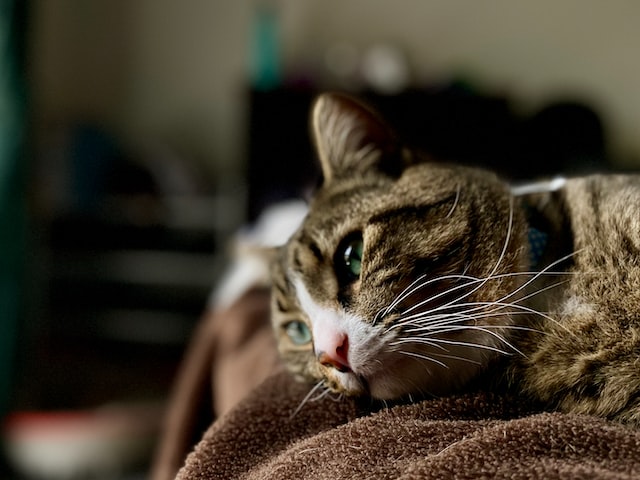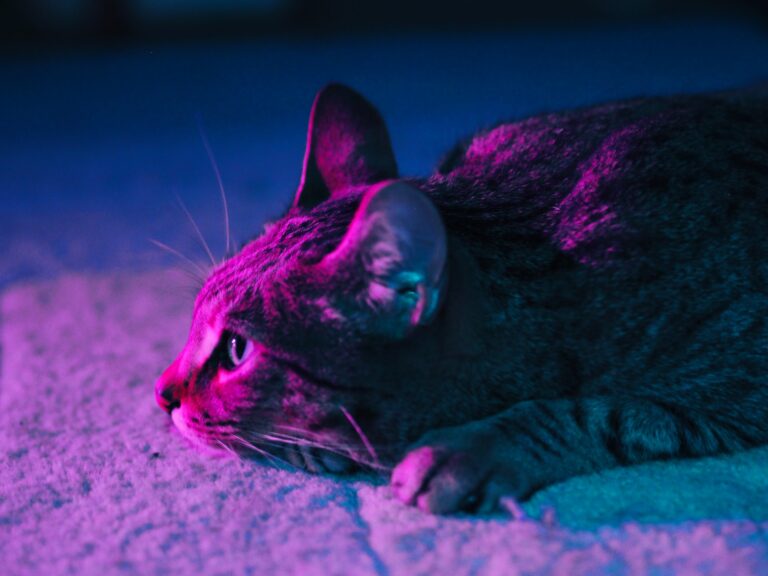Do cats have periods? Tell me the Estrus cycle?
Cats’ periods (called the estrus cycle) are longer than that of humans. It generally lasts about 4 to 10 days, though it can be as short as 3 days or as long as 12.
This period of time is usually accompanied by signs like restlessness, increased vocalization (meowing/caterwauling), rolling around on the ground or rubbing herself against objects repeatedly to express her desire to mate. She will also lick her genital area frequently and there might be blood stains found in her litter box perhaps due to licking herself after she urinates or defecates.
Benefits of Spaying Your Cat
Spayed cats are less likely to develop mammary tumors.
unspayed female cats are at risk of developing pyometra, a serious infection of the uterus that requires immediate veterinary attention.
Spaying eliminates the possibility of uterine or ovarian cancer which is common in older, unspayed females.
A spayed cat will not have heat periods. This means no yowling and escaping to find a mate during “that time of the month.”
Cats can become pregnant during their first heat cycle. An unspayed female cat can fall pregnant at just 4 months old! That’s why it’s important to get your young kitties spayed before their first heat.
Spaying – The Facts
Now is the time to have your cat spayed.
Learn about the benefits of spaying your cat and how it will change their life.
Your cat can stay calmer, healthier and live a longer life with these procedures done at a young age.
Procedures often include: –Spay (ovariohysterectomy) which involves removing both ovaries, the uterus and sometimes part of the vagina. Your vet may also remove one or two sections of each fallopian tube in order to prevent pregnancy-related cancers from developing later in life. This procedure is usually performed under general anesthetic by making an incision in front of your pet’s belly button.- Neuter (castration) which involve removing a male pet ‘s testicles. This procedure is usually performed under general anesthetic by making an incision in front of your pet’s belly button.- Declawing which involves the complete removal of a cat’s claws, including their knuckles.
Cats can become pregnant during their first heat cycle. An un-spayed female cat can fall pregnant at just 4 months old! That’s why it’s important to get your young kitties spayed before their first heat.
Spaying is also referred to as ovariohysterectomy (OHE) or “fixing” and the operation is quite simple and straightforward when performed on a healthy animal by an experienced veterinarian The benefits of spaying:
Spayed cats are less likely to develop mammary tumors.
unspayed female cats are at risk of developing pyometra, a serious infection of the uterus that requires immediate veterinary attention.
Spaying eliminates the possibility of uterine or ovarian cancer which is common in older, unspayed females.
A spayed cat will not have heat periods. This means no yowling and escaping to find a mate during “that time of the month.”
Cats can become pregnant during their first heat cycle. An unspayed female cat can fall pregnant at just 4 months old! That’s why it’s important to get your young kitties spayed before their first heat.
The myth about getting your cats “fixed” makes them fat: FALSE!
The answer to a common myth about cats becoming fat after being spayed or neutered is no. There is no truth in this whatsoever.
When you have your cat spayed, they go through a ‘menopause-like’ experience so their hormones will reduce and they won’t be as hungry.
There is even some evidence that spaying or neutering can prevent certain types of cancer and reduce the risk of your cat having a heart attack.
Your cat really does need to be “fixed” if: – You want to do your best for your pet’s health and welfare. Make sure to ask the vet about any risks involved when considering whether to get your pet spayed or neutered.
As with any surgical procedure, there are some risks involved when having your pet spayed or neutered.
However, these procedures are very well-tolerated in most pets and the benefits far outweigh the risks for many reasons.
If you have any concerns about either of these procedures, be sure to talk to your vet.
You can also visit www.shelterclinic.com for more information about spaying and neutering your pet.
Do cats have periods after being spayed?
Yes, cats have periods after being spayed.
No more than a normal cat’s period of a few days of bleeding and discomfort if everything is healthy and going well. – You want to ensure your pet doesn’t have any accidental litters of kittens before they’re old enough to be safely taken away from their mother.
If you want to do your part for this, spaying and neutering also reduces the stray pet population.
If you have further questions about spaying or neutering your cat, contact your veterinarian for information specific to your pet’s health.
Is spaying/neutering good for cats? – Spaying is a surgical procedure where ovaries and uterus are removed from a female animal.
Neutering is a surgical procedure where testicles and sometimes penis of male animals is removed.
Spaying and neutering has both benefits and risks associated with it. We will discuss some of them in this post.
Cat Having Heat Symptoms After Being Spayed
“Spaying is a surgical procedure where ovaries and uterus are removed from a female animal.”
Some of the benefits of spaying include: – Decreased risk of certain types of cancers, especially breast cancer. – Prevents unwanted litters; there will be no “accidental” pregnancies.
“Neutering is a surgical procedure where testicles and sometimes penis of male animals is removed.”
It will also decrease the risk of certain diseases, such as testicular cancer.

How much does it cost to spay/neuter a dog or cat ?
The cost of spaying a cat is around $200 -$400. The cost may vary depending on where you live and the type of procedure that needs to be done.
On an average, the cost of neutering a tom (male) and a female dog is $150 -$200.
The cost may vary depending on where you live and the type of procedure that needs to be done.
There are some hidden costs also which you need to consider while getting your pet spayed or neutered.
They include: – check-ups before surgery, – pre-surgical blood tests, – anesthetics and facilities costs, if done under general anesthesia. Also, the cost of spaying or neutering will be more for a larger animal.
Does spaying/neutering make your pet fat or lazy?
No, spaying and neutering does not make your pet fat or lazy.
In fact, pets become more active after being fixed as they won’t be driven by their hormones to roam around searching for a mate. Also, spayed and neutered dogs and cats may live longer too. How much does it cost to
How does the Estrus Cycle affect my cat?
The estrus cycle (in cats known as “heat”) lasts an average of 4 to 7 days. During this time, a female cat will show signs that she is in heat such as: – Cat Cleaning Herself More Frequently – Rolling Around on the floor and Making Whimpering Noises – Treading air with her back legs – Acting more affectionate than normal – Not allowing herself to be picked up or touched by anyone besides family members – Increased Thirst and Urination How does the Estrus Cycle affect my cat?
The estrus cycle (in cats known as “heat”) lasts an average of 4 to 7 days. During this time, a female cat will show signs that she is in heat such as:
– Cat Cleaning Herself More Frequently
– Rolling Around on the floor and Making Whimpering Noises
– Treading air with her back legs
– Acting more affectionate than normal
– Not allowing herself to be picked up or touched by anyone besides family members
– Increased Thirst and Urination
Immediately after estrus, a female cat may experience a phase called diestrus. Diestrus usually lasts an average of 63 days. During this time the female cat will:
– Show decreased affection toward family members and other pets she is familiar with – Protect territory by showing aggression toward strangers and other pets – May spray urine to mark territory How does the Estrus Cycle affect my cat?
Immediately after estrus, a female cat may experience a phase called diestrus. Diestrus usually lasts an average of 63 days. During this time the female cat will: – Show decreased affection toward family members and other pets she is familiar with – Protect territory by showing aggression toward strangers and other pets – May spray urine to mark territory
Puberty in kittens usually occurs around 6 months of age, but it may vary depending on the breed. Females who are spayed at puberty will not go through heat cycle. However, they can still get pregnant.
What should I do if my cat is hot?
– Keep the cat indoors and do not allow her to roam
– Provide plenty of water
– Restrict heavy exercise
– Provide cooling pads or ice packs to the groin area
– Offer your pet moist foods, such as canned tuna mixed with dry food.
How will this cycle affect my cat?
The estrus cycle (in cats known as “heat”) lasts an average of 4 to 7 days. During this time, a female cat will show signs that she is in heat such as: – Cat Cleaning Herself More Frequently – Rolling Around on the floor and Making Whimpering Noises – Treading air with her back legs – Acting more affectionate than normal – Not allowing herself to be picked up or touched by anyone besides family members – Increased Thirst and Urination How will this cycle affect my cat?
– The female cat may experience behavioral changes, such as increased affection toward family members and other pets she is familiar with, or aggression towards strangers and other pets.

